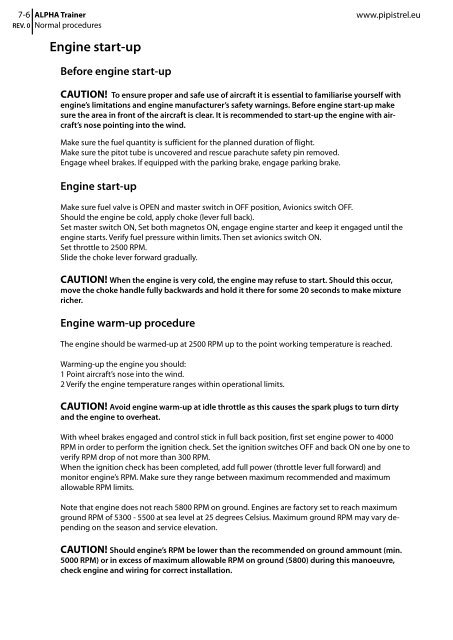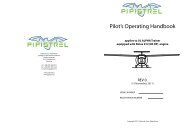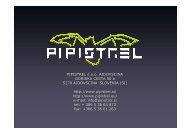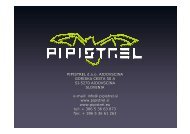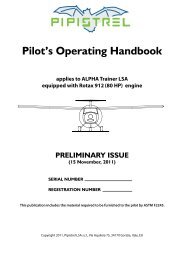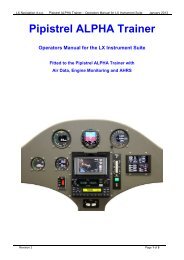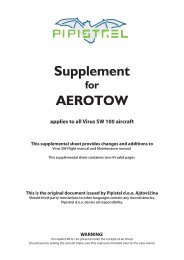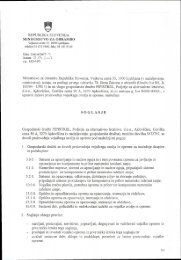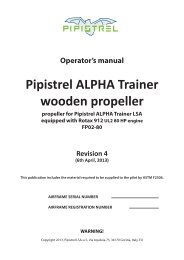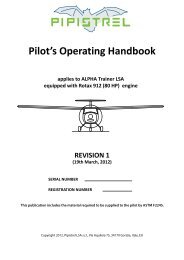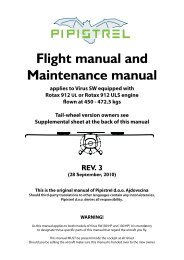You also want an ePaper? Increase the reach of your titles
YUMPU automatically turns print PDFs into web optimized ePapers that Google loves.
7-6 <strong>ALPHA</strong> <strong>Trainer</strong><br />
REV. 0 Normal procedures<br />
www.pipistrel.eu<br />
Engine start-up<br />
Before engine start-up<br />
CAUTION! To ensure proper and safe use of aircraft it is essential to familiarise yourself with<br />
engine’s limitations and engine manufacturer’s safety warnings. Before engine start-up make<br />
sure the area in front of the aircraft is clear. It is recommended to start-up the engine with aircraft’s<br />
nose pointing into the wind.<br />
Make sure the fuel quantity is sufficient for the planned duration of flight.<br />
Make sure the pitot tube is uncovered and rescue parachute safety pin removed.<br />
Engage wheel brakes. If equipped with the parking brake, engage parking brake.<br />
Engine start-up<br />
Make sure fuel valve is OPEN and master switch in OFF position, Avionics switch OFF.<br />
Should the engine be cold, apply choke (lever full back).<br />
Set master switch ON, Set both magnetos ON, engage engine starter and keep it engaged until the<br />
engine starts. Verify fuel pressure within limits. Then set avionics switch ON.<br />
Set throttle to 2500 RPM.<br />
Slide the choke lever forward gradually.<br />
CAUTION! When the engine is very cold, the engine may refuse to start. Should this occur,<br />
move the choke handle fully backwards and hold it there for some 20 seconds to make mixture<br />
richer.<br />
Engine warm-up procedure<br />
The engine should be warmed-up at 2500 RPM up to the point working temperature is reached.<br />
Warming-up the engine you should:<br />
1 Point aircraft’s nose into the wind.<br />
2 Verify the engine temperature ranges within operational limits.<br />
CAUTION! Avoid engine warm-up at idle throttle as this causes the spark plugs to turn dirty<br />
and the engine to overheat.<br />
With wheel brakes engaged and control stick in full back position, first set engine power to 4000<br />
RPM in order to perform the ignition check. Set the ignition switches OFF and back ON one by one to<br />
verify RPM drop of not more than 300 RPM.<br />
When the ignition check has been completed, add full power (throttle lever full forward) and<br />
monitor engine’s RPM. Make sure they range between maximum recommended and maximum<br />
allowable RPM limits.<br />
Note that engine does not reach 5800 RPM on ground. Engines are factory set to reach maximum<br />
ground RPM of 5300 - 5500 at sea level at 25 degrees Celsius. Maximum ground RPM may vary depending<br />
on the season and service elevation.<br />
CAUTION! Should engine’s RPM be lower than the recommended on ground ammount (min.<br />
5000 RPM) or in excess of maximum allowable RPM on ground (5800) during this manoeuvre,<br />
check engine and wiring for correct installation.


